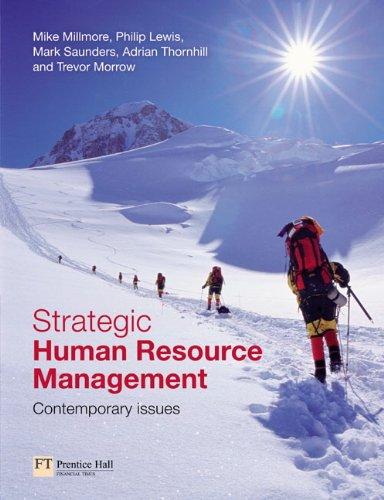DaimlerChryslers product portfolio ranges from small cars to sports cars and luxury sedans; and from versatile vans
Question:
DaimlerChryslers’ product portfolio ranges from small cars to sports cars and luxury sedans; and from versatile vans to trucks and coaches. Daimler-
Chryslers’ passenger car brands include Maybach, Mercedes-Benz, Chrysler, Jeep®, Dodge and Smart. Commercial vehicle brands include Mercedes-
Benz, Freightliner, Sterling, Western Star, Setra and Mitsubishi Fuso. It offers financial and other automotive services through DaimlerChrysler Financial Services.
DaimlerChrysler (DC) has a global workforce (382,723 at year-end 2005) and a global shareholder base. DaimlerChrysler achieved revenues of €149.7 billion in 2005. The operative result was €5.1 billion for 2005 (Mercedes Car Group a loss of €505 million!).
DC has been described as a very traditional German company. For a long time its culture has been described as technology- and qualityfocused:
brilliant engineers and craftsmen were producing well-designed, reliable, high-quality cars.
Under the shining Mercedes star, managers could afford to buy companies all over the world as the coffer was full. Unfortunately, too often they paid too much for companies which did not fit in their organisational structure.
Meanwhile, the reputation of the Mercedes star has dimmed and Mercedes has slid dramatically in consumer rankings and loyalty. DC appears to have quality problems, manufacturing efficiency has declined (while costs are relatively high) and there has been excess production capacity for years. Also, its technological prowess is more and more disputed.
The giant head office (HO) in Stuttgart-Möhringen monitors hundreds of national and international companies in different industries. There are manufacturing facilities in 17 countries. Most Group companies are in fact (economically) more or less independent as it is very difficult to stir these companies ‘virtually’ from the HO.
Dieter Zetsche became group chief executive at the start of the year 2006 succeeding Jürgen Schrempp.
In September 2005 Zetsche warned: ‘We should not let ourselves become overconfident. There is still a long and difficult road ahead of us before we can become truly competitive again.’ The company continues to drag around excess production capacity, he wrote, and its costs remain ‘significantly higher than those of the best competitors’. To redress the situation, he announced, Daimler-
Chrysler’s board was cutting 8,500 Mercedes jobs in Germany, or about 9 per cent of the total.........
Questions
1. As the HR-Director of DC (Stuttgart, Germany)
you are required to develop a ‘suitable HR strategy’ to propose solutions to the problems raised by the actual situation of DC and the intentions of the CEO described above.
State your understanding of the situation at DC and determine the needs of DC (problems within DC and reasons for the new organisational structure); also describe some strategic elements of the organisational structure.
2. Whereas German companies such as Deutsche Bank AG, Lufthansa AG or Allianz AG are seen by HR specialists and scholars as ‘truly’ global companies with excellent strategic HRM policies, DaimlerChrysler lacks such a reputation. There were incredible problems integrating Chrysler in the DC group. It took years to fix many post-merger problems. There are many other examples of a poor international HR policy of DC. This may also be a reflection of a generally rather poor (strategic) HR management of DC’s head office.
You are therefore also asked to answer the following questions:
• In light of the intentions in the announcement of DC (text above) which HR areas or HR challenges are concerned?
• Name some of these challenges. Then establish a plan of action by formulating and justifying possible solutions to the challenges you have identified.
3. What type of organisational structure should be created and implemented to support the new HR strategy?
4. What are possible advantages (and disadvantages) of creating a new organisational structure?
5. In developing and implementing the new structures, the company will have to recruit new international managers. How could the company really select and develop a group of experienced international managers? What instruments would you use?
Step by Step Answer:

Strategic Human Resource Management Contemporary Issues
ISBN: 9780273681632
1st Edition
Authors: Mark N. K. Saunders; Mike Millmore; Philip Lewis; Adrian Thornhill; Trevor Morrow





